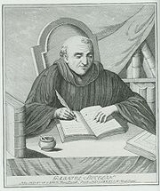
Gabriel Bucelin
Encyclopedia

Diessenhofen
Diessenhofen is a municipality in Frauenfeld District in the canton of Thurgau in Switzerland.-History:Diessenhofen is first mentioned in 757 as Deozincova. In 2000, the village of Willisdorf was incorporated into the municipality...
, Thurgau
Thurgau
Thurgau is a northeast canton of Switzerland. The population, , is . In 2007, there were a total of 47,390 who were resident foreigners. The capital is Frauenfeld.-History:...
—June 9, 1681, Weingarten) was a Benedictine
Benedictine
Benedictine refers to the spirituality and consecrated life in accordance with the Rule of St Benedict, written by Benedict of Nursia in the sixth century for the cenobitic communities he founded in central Italy. The most notable of these is Monte Cassino, the first monastery founded by Benedict...
polymath, Humanist, historical writer and cartographer.
Life
A scion of the distinguished line of Bucellini counts, Gabriel, at the age of thirteen, entered the Benedictine monastery at Weingarten. After a course in philosophy and theology at the Jesuit University of DillingenUniversity of Dillingen
The University of Dillingen, at Dillingen an der Donau in southern Germany, existed from 1551 to 1803. It was located in Swabia, then a district of Bavaria.-Foundation:...
he was ordained a priest on April 23, 1624. In the same year he was sent, as master of novices, to restore the primitive fervour and raise the standard of studies in the monastery of St. Trudpert in the Black Forest
Black Forest
The Black Forest is a wooded mountain range in Baden-Württemberg, southwestern Germany. It is bordered by the Rhine valley to the west and south. The highest peak is the Feldberg with an elevation of 1,493 metres ....
. In 1627 he became secretary to Abbott Franz Dietrich and to the Swabian Benedictine congregation. He filled the position of master of novices at Weingarten and professor of humanities at Feldkirch (1635), from which on the approach of the Swedish army he was forced to flee to Vienna, Venice, and finally Admont
Admont
Admont is a town in Styria, Austria, with a population of 2775 . It is historically most notable for Admont Abbey, a monastery founded in 1074.-External links:* *...
(1646). There he was appointed prior of St. John's monastery, Feldkirch (1651), where he remained until a few months before his death, when he returned to Weingarten.
Works
Bucelin was a universal scholar and a very prolific writer, being the author of some fifty-three works on genealogy, world history, hagiography and church history. He also drew maps and plans. A large number of his works are still in manuscript in the state library at StuttgartStuttgart
Stuttgart is the capital of the state of Baden-Württemberg in southern Germany. The sixth-largest city in Germany, Stuttgart has a population of 600,038 while the metropolitan area has a population of 5.3 million ....
. Many of his works remained unpublished, perhaps because of the disruptions of war. His chief claim to contemporary fame lies in the fact that he was, if not the first, at least among the first authors to deal with the ecclesiastical history of Germany. Of his published works the most important are:
- Germania sacra (Augsburg, 1655), containing accounts of the principal ecclesiastics, archbishops, abbots, etc., as well as a list of the most important monasteries of Germany
- Germaniae topo-chrono-stemmatographia sacra et profana (1665-78), treating, as its name implies, of the genealogy of the most distinguished members of the clergy and the nobility
- Constantia sacra et profana (Frankfort, 1667)
- Rhaetia etrusca, romana, gallica, germanica (Augsburg, 1661)
- Nuclei Historiae universalis cum sacrae... (Ulm, 1650, 1654; carried from 1650 to 1735 by Schmier, Apparatum ad theologiam scholastico-polemico-practicam), of great importance to scholars interested in ancient charts, bulls, diplomata, etc.
Bucelin was also the author of many works on the Benedictine Order and its most illustrious members, among them Aquila imperii benedictina (Venice, 1651), Annales Benedictini (Vienna 1655, Augsburg 1656) and Menologium benedictinum (Feldkirch, 1655).

